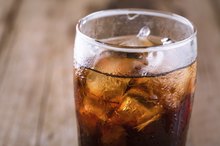Does Soda Affect Arthritis?
More than 50 million Americans have been diagnosed with arthritis – one in every five adults – making it the leading cause of disability in the United States, according to the Centers for Disease Control and Prevention 1. Arthritis is an umbrella term encompassing more than 100 diseases that cause stiffness, pain and swelling of the joints, and includes osteoarthritis, gout, fibromyalgia, lupus and rheumatoid arthritis. Some foods, like soda, increase the probability of developing or inflaming arthritic conditions, particularly when consumed in excess.
If you are experiencing serious medical symptoms, seek emergency treatment immediately.
Health Professionals Follow-Up Study
A study published in the "British Medical Journal" examined the correlation between sugary drinks such as soda and the occurrence of gout in men. In the 12-year Health Professionals Follow-up Study, American and Canadian researchers observed 46,000 middle-aged men with no history of gout. The men routinely completed questionnaires regarding their dietary habits and provided information on their weight and any medical conditions and medications.
Study Results
Gout & Diet Soda
Learn More
During the 12-year time frame, 755 new cases of gout were diagnosed. Men who daily consumed two or more sodas had an 85 percent higher incidence of developing gout than those who drank less than one soda a month. Men who drank one soda daily had a 45 percent higher incident rate. Diet soda did not increase the risk, but both fruit juice and fruits high in fructose did. However, since the consumption of oranges, apples and other high fructose fruits help prevent some cancers as well as high blood pressure, stroke and heart disease, the authors advise weighing the data against the benefits of fruit consumption.
- During the 12-year time frame, 755 new cases of gout were diagnosed.
- Men who daily consumed two or more sodas had an 85 percent higher incidence of developing gout than those who drank less than one soda a month.
Joint Inflammation
Sodas also are one of the culprits associated with inflammation of arthritic joints. Marcelle Pick, co-founder of the Women to Women Clinic, lists both diet and regular soft drinks, fruit juices and all forms of natural and refined sugar as inflammation-fueling foods, particularly when consumed at night 3. Pick states, “It’s interesting how some women who eat (or drink) refined carbohydrates at night are also more likely to have fluid retention and morning pain, and how changing just this one habit can turn joint pain around — almost overnight.”
Soda to Relieve Arthritis
The Disadvantages of Soft Drinks
Learn More
According to RaleighChiropractic.com, some people drink a six-pack of soft drinks to diminish the pain of arthritis 4. This does provide temporary relief since the phosphate in the soda dissolves calcium deposits in the joints; however, the site warns against this practice and cautions that regularly consuming a six-pack of soft drinks will lead to osteoporosis since the soda’s phosphate also dissolves calcium in the bones.
Related Articles
References
- Centers for Disease Control and Prevention; Arthritis
- Arthritis Today: Soda Increases Risk of Gout
- Women to Women; Inflammation-Joint Pain and Arthritis; Marcelle Pick; April 2011
- Raleigh Chiropractic: Arthritis, Pain Relief and Soft Drinks
- Coca-Cola Bottle, 12 fl oz. U.S. Department of Agriculture. Published February 27, 2020.
- 2015-2020 Dietary Guidelines for Americans. U.S. Department of Health and Human Services.
- How much sugar is too much? American Heart Association.
- Freeman CR, Zehra A, Ramirez V, Wiers CE, Volkow ND, Wang GJ. Impact of sugar on the body, brain, and behavior. Front Biosci (Landmark Ed). 2018;23:2255-2266. Published 2018 Jun 1.
- Pasiakos SM, McLellan TM, Lieberman HR. The effects of protein supplements on muscle mass, strength, and aerobic and anaerobic power in healthy adults: a systematic review. Sports Med. 2015;45(1):111-131. doi:10.1007/s40279-014-0242-2
- Blom WA, Lluch A, Stafleu A, et al. Effect of a high-protein breakfast on the postprandial ghrelin response. Am J Clin Nutr. 2006;83(2):211-220. doi:10.1093/ajcn/83.2.211
- Tipton KD. Nutritional Support for Exercise-Induced Injuries. Sports Med. 2015;45 Suppl 1:S93-S104. doi:10.1007/s40279-015-0398-4
- Kerstetter JE, Kenny AM, Insogna KL. Dietary protein and skeletal health: a review of recent human research. Curr Opin Lipidol. 2011;22(1):16-20. doi:10.1097/MOL.0b013e3283419441
- Paddon-Jones D, Short KR, Campbell WW, Volpi E, Wolfe RR. Role of dietary protein in the sarcopenia of aging. Am J Clin Nutr. 2008 May;87(5):1562S-1566S. doi: 10.1093/ajcn/87.5.1562S. PMID: 18469288.
- Maughan RJ, Griffin J. Caffeine ingestion and fluid balance: a review. J Hum Nutr Diet. 2003 Dec;16(6):411-20. doi: 10.1046/j.1365-277x.2003.00477.x. PMID: 19774754.
- Lete I, Allué J. The Effectiveness of Ginger in the Prevention of Nausea and Vomiting during Pregnancy and Chemotherapy. Integr Med Insights. 2016;11:11-17. Published 2016 Mar 31. doi:10.4137/IMI.S36273
- Laura Helm, Ian A. Macdonald, Impact of beverage intake on metabolic and cardiovascular health, Nutrition Reviews, Volume 73, Issue suppl_2, 1 September 2015, Pages 120–129, https://doi.org/10.1093/nutrit/nuv049
- Ma J, Jacques PF, Meigs JB, et al. Sugar-Sweetened Beverage but Not Diet Soda Consumption Is Positively Associated with Progression of Insulin Resistance and Prediabetes. J Nutr. 2016;146(12):2544-2550. doi:10.3945/jn.116.234047
- Rippe JM, Angelopoulos TJ. Relationship between Added Sugars Consumption and Chronic Disease Risk Factors: Current Understanding. Nutrients. 2016;8(11):697. Published 2016 Nov 4. doi:10.3390/nu8110697
- Bucher Della Torre S, Keller A, Laure Depeyre J, Kruseman M. Sugar-Sweetened Beverages and Obesity Risk in Children and Adolescents: A Systematic Analysis on How Methodological Quality May Influence Conclusions. J Acad Nutr Diet. 2016;116(4):638-659. doi:10.1016/j.jand.2015.05.020
- Bray GA, Nielsen SJ, Popkin BM. Consumption of high-fructose corn syrup in beverages may play a role in the epidemic of obesity [published correction appears in Am J Clin Nutr. 2004 Oct;80(4):1090]. Am J Clin Nutr. 2004;79(4):537-543. doi:10.1093/ajcn/79.4.537
- Vartanian LR, Schwartz MB, Brownell KD. Effects of soft drink consumption on nutrition and health: a systematic review and meta-analysis. Am J Public Health. 2007;97(4):667-675. doi:10.2105/AJPH.2005.083782
- Pollock NK, Bundy V, Kanto W, et al. Greater fructose consumption is associated with cardiometabolic risk markers and visceral adiposity in adolescents [published correction appears in J Nutr. 2013 Jan;143(1):123]. J Nutr. 2012;142(2):251-257. doi:10.3945/jn.111.150219
- Elffers TW, de Mutsert R, Lamb HJ, et al. Body fat distribution, in particular visceral fat, is associated with cardiometabolic risk factors in obese women. PLoS One. 2017;12(9):e0185403. Published 2017 Sep 28. doi:10.1371/journal.pone.0185403
- Yudkin J. Sugar and ischaemic heart disease. Practitioner. 1967;198(187):680-683.
- Liu S, Willett WC, Stampfer MJ, et al. A prospective study of dietary glycemic load, carbohydrate intake, and risk of coronary heart disease in US women. Am J Clin Nutr. 2000;71(6):1455-1461. doi:10.1093/ajcn/71.6.1455
- Cohen L, Curhan G, Forman J. Association of sweetened beverage intake with incident hypertension. J Gen Intern Med. 2012;27(9):1127-1134. doi:10.1007/s11606-012-2069-6
- Welsh JA, Sharma A, Cunningham SA, Vos MB. Consumption of added sugars and indicators of cardiovascular disease risk among US adolescents. Circulation. 2011;123(3):249-257. doi:10.1161/CIRCULATIONAHA.110.972166
- Assy N, Nasser G, Kamayse I, et al. Soft drink consumption linked with fatty liver in the absence of traditional risk factors. Can J Gastroenterol. 2008;22(10):811-816. doi:10.1155/2008/810961
- Jiantao Ma, Caroline S. Fox, Paul F. Jacques, Elizabeth K. Speliotes, Udo Hoffmann, Caren E. Smith, Edward Saltzman, Nicola M. McKeown,Sugar-sweetened beverage, diet soda, and fatty liver disease in the Framingham Heart Study cohorts. Journal of Hepatology 63;2(2015). https://doi.org/10.1016/j.jhep.2015.03.032.
- Avena NM, Bocarsly ME, Hoebel BG. Animal models of sugar and fat bingeing: relationship to food addiction and increased body weight. Methods Mol Biol. 2012;829:351-365. doi:10.1007/978-1-61779-458-2_23
- Avena NM, Rada P, Hoebel BG. Evidence for sugar addiction: behavioral and neurochemical effects of intermittent, excessive sugar intake. Neurosci Biobehav Rev. 2008;32(1):20-39. doi:10.1016/j.neubiorev.2007.04.019
- Choi HK, Willett W, Curhan G. Fructose-rich beverages and risk of gout in women. JAMA. 2010;304(20):2270-2278. doi:10.1001/jama.2010.1638
- Choi HK, Curhan G. Soft drinks, fructose consumption, and the risk of gout in men: prospective cohort study. BMJ. 2008;336(7639):309-312. doi:10.1136/bmj.39449.819271.BE
- Jamnik J, Rehman S, Blanco Mejia S, et al. Fructose intake and risk of gout and hyperuricemia: a systematic review and meta-analysis of prospective cohort studies. BMJ Open. 2016;6(10):e013191. Published 2016 Oct 3. doi:10.1136/bmjopen-2016-013191
- Tooth. American Dental Association. https://www.mouthhealthy.org/en/az-topics/t/tooth.
- Cheng R, Yang H, Shao MY, Hu T, Zhou XD. Dental erosion and severe tooth decay related to soft drinks: a case report and literature review. J Zhejiang Univ Sci B. 2009;10(5):395-399. doi:10.1631/jzus.B0820245
- Hanover LM, White JS. Manufacturing, composition, and applications of fructose. Am J Clin Nutr. 1993;58(5 Suppl):724S-732S. doi:10.1093/ajcn/58.5.724S
- Meghan B. Azad, Ahmed M. Abou-Setta, Bhupendrasinh F. Chauhan, et al. Nonnutritive sweeteners and cardiometabolic health: a systematic review and meta-analysis of randomized controlled trials and prospective cohort studies. CMAJ Jul 2017, 189 (28) E929-E939; DOI: 10.1503/cmaj.161390
- Fowler, S.P., Williams, K., Resendez, R.G., Hunt, K.J., Hazuda, H.P. and Stern, M.P. (2008), Fueling the Obesity Epidemic? Artificially Sweetened Beverage Use and Long‐term Weight Gain. Obesity, 16: 1894-1900. doi:10.1038/oby.2008.284
- Fowler SP, Williams K, Hazuda HP. Diet soda intake is associated with long-term increases in waist circumference in a biethnic cohort of older adults: the San Antonio Longitudinal Study of Aging. J Am Geriatr Soc. 2015;63(4):708-715. doi:10.1111/jgs.13376
Writer Bio
Terri Williams began writing professionally in 1997, serving as media manager for a large nonprofit organization where she also edited books and created promotional content. She has written extensively on business communication, ethics, leadership, management, education and health. Williams has a Bachelor of Arts in English from the University of Alabama at Birmingham.









